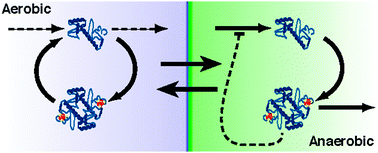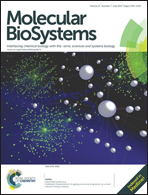Design principles of a conditional futile cycle exploited for regulation†
Abstract
In this report, we characterize the design principles of futile cycling in providing rapid adaptation by regulatory proteins that act as environmental sensors. In contrast to the energetically wasteful futile cycles that are avoided in metabolic pathways, here we describe a conditional futile cycle exploited for a regulatory benefit. The FNR (fumarate and nitrate reduction) cycle in Escherichia coli operates under two regimes – a strictly futile cycle in the presence of O2 and as a pathway under anoxic conditions. The computational results presented here use FNR as a model system and provide evidence that cycling of this transcription factor and its labile sensory cofactor between active and inactive states affords rapid signaling and adaptation. We modify a previously developed mechanistic model to examine a family of FNR models each with different cycling speeds but mathematically constrained to be otherwise equivalent, and we identify a trade-off between energy expenditure and response time that can be tuned by evolution to optimize cycling rate of the FNR system for a particular ecological context. Simulations mimicking experiments with proposed double mutant strains offer suggestions for experimentally testing our predictions and identifying potential fitness effects. Our approach provides a computational framework for analyzing other conditional futile cycles, which when placed in their larger biological context may be found to confer advantages to the organism.


 Please wait while we load your content...
Please wait while we load your content...